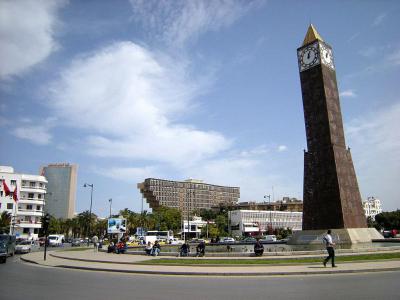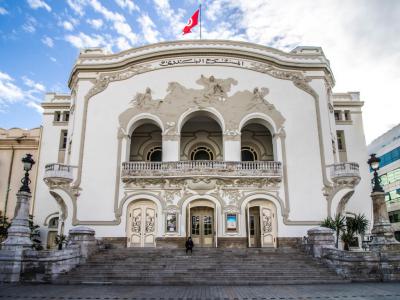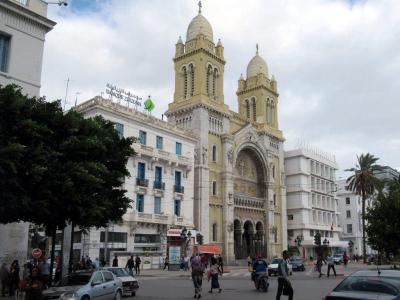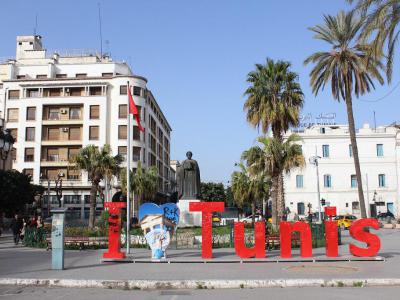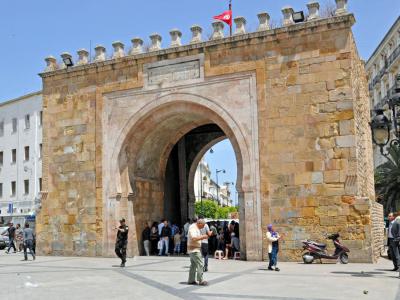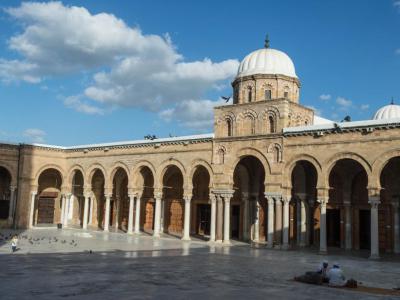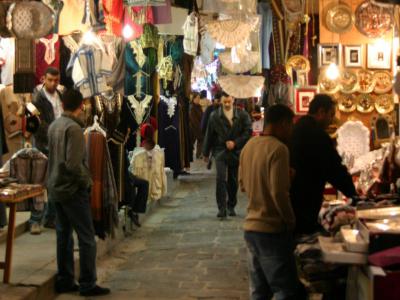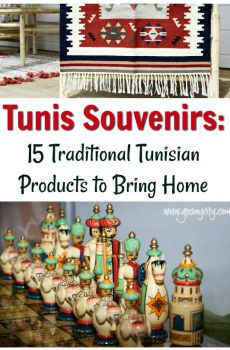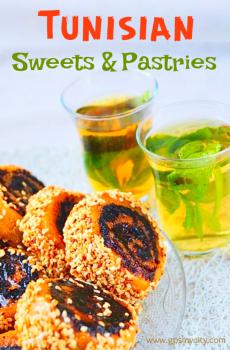Tunis Introduction Walking Tour (Self Guided), Tunis
Tunis is the capital of Tunisia and one of the largest cities in the Arab world. Tunis was a Berber settlement founded on and around the ancient city of Carthage. The settlement of Tunis dates as far back as the 4th century BCE. It became the capital city in 1159.
The city was controlled by numerous empires over the years, which has lent to its interesting art and architecture. With influences from the Umayyad Caliphate, the Ottoman empire, the Spanish and, most recently, the French, Tunis is an eclectic and historically vibrant city.
Tunisia gained independence from France in 1956. The country became a sovereign nation with Tunis serving as its seat of power. The Tunisian Revolution took place in 2011, which led to the Arab Spring. Many Arab nations changed hands during this time, which can be traced to the self-immolation of Mohamed Bouazizi in front of the provincial governor's office.
Visitors to Tunisia can see the past and the present unite by touring this city on foot. The 14th January Square recognizes the Tunisian Revolution with a memorial in the midst of the bustling city. The pedestrian-friendly city has wide streets that are peppered with restaurants, shopping and historic spots. Walk down Avenue Habib Bourguiba and take a stroll around Independence Square to see some of the best of the city.
For a fun venture into life in Tunisia, don't forget to patronize the souks. These shops have something for everyone, with food, drink, clothing, souvenirs and much more to take home and enjoy. There is also the Gate of France, which leads to the oldest part of Tunisia: the Medina.
Don't pass up the opportunity to see the ruins of Carthage by going on a Carthage walking tour. You'll take a trip back in time when you stroll through the UNESCO World Heritage site.
Take this self-guided walking tour to explore all that Tunis has to offer.
The city was controlled by numerous empires over the years, which has lent to its interesting art and architecture. With influences from the Umayyad Caliphate, the Ottoman empire, the Spanish and, most recently, the French, Tunis is an eclectic and historically vibrant city.
Tunisia gained independence from France in 1956. The country became a sovereign nation with Tunis serving as its seat of power. The Tunisian Revolution took place in 2011, which led to the Arab Spring. Many Arab nations changed hands during this time, which can be traced to the self-immolation of Mohamed Bouazizi in front of the provincial governor's office.
Visitors to Tunisia can see the past and the present unite by touring this city on foot. The 14th January Square recognizes the Tunisian Revolution with a memorial in the midst of the bustling city. The pedestrian-friendly city has wide streets that are peppered with restaurants, shopping and historic spots. Walk down Avenue Habib Bourguiba and take a stroll around Independence Square to see some of the best of the city.
For a fun venture into life in Tunisia, don't forget to patronize the souks. These shops have something for everyone, with food, drink, clothing, souvenirs and much more to take home and enjoy. There is also the Gate of France, which leads to the oldest part of Tunisia: the Medina.
Don't pass up the opportunity to see the ruins of Carthage by going on a Carthage walking tour. You'll take a trip back in time when you stroll through the UNESCO World Heritage site.
Take this self-guided walking tour to explore all that Tunis has to offer.
How it works: Download the app "GPSmyCity: Walks in 1K+ Cities" from Apple App Store or Google Play Store to your mobile phone or tablet. The app turns your mobile device into a personal tour guide and its built-in GPS navigation functions guide you from one tour stop to next. The app works offline, so no data plan is needed when traveling abroad.
Tunis Introduction Walking Tour Map
Guide Name: Tunis Introduction Walking Tour
Guide Location: Tunisia » Tunis (See other walking tours in Tunis)
Guide Type: Self-guided Walking Tour (Sightseeing)
# of Attractions: 8
Tour Duration: 1 Hour(s)
Travel Distance: 1.8 Km or 1.1 Miles
Author: leticia
Sight(s) Featured in This Guide:
Guide Location: Tunisia » Tunis (See other walking tours in Tunis)
Guide Type: Self-guided Walking Tour (Sightseeing)
# of Attractions: 8
Tour Duration: 1 Hour(s)
Travel Distance: 1.8 Km or 1.1 Miles
Author: leticia
Sight(s) Featured in This Guide:
- Place du 14 Janvier (14th January Square)
- Avenue Habib Bourguiba
- Théâtre Municipal (Municipal Theatre)
- Cathédrale Saint-Vincent-de-Paul (St. Vincent de Paul Cathedral)
- Place de l'Independance (Independence Square)
- Bab el Bhar (Gate of France)
- Mosquée Zitouna (Mosque of Olive)
- Souks of Tunis
1) Place du 14 Janvier (14th January Square)
14th January Square is a commemorative square in honor of the Tunisian Revolution that began on January 14, 2011. The catalyst for the revolution was the self-immolation of Mohamed Bouazizi who was protesting mistreatment by the government. This was the beginning not just of the Tunisian Revolution but of the Arab Spring that took place in Libya, Egypt, Yemen, Syria and Bahrain.
The square was previously called Africa Square. It held the monument of Jules Ferry, former Prime Minister of France. In 1956, when Tunisia gained independence from France, the statue was replaced with an equestrian statue of President Habib Bourguiba who was the first president of Tunisia. That statue was removed after the president was ousted from office in 1987.
A clock tower was added to the square where the statues previously stood. It is surrounded by a reflecting pool and a fountain of dancing water. Following the 2011 revolution, the equestrian statue of Bourguiba returned to the west of the square on June 1, 2016.
The square was previously called Africa Square. It held the monument of Jules Ferry, former Prime Minister of France. In 1956, when Tunisia gained independence from France, the statue was replaced with an equestrian statue of President Habib Bourguiba who was the first president of Tunisia. That statue was removed after the president was ousted from office in 1987.
A clock tower was added to the square where the statues previously stood. It is surrounded by a reflecting pool and a fountain of dancing water. Following the 2011 revolution, the equestrian statue of Bourguiba returned to the west of the square on June 1, 2016.
2) Avenue Habib Bourguiba
Avenue Habib Bourguiba is the main thoroughfare in Tunis. It spans from Labor Exchange Street (Rue de la Bourse du Travail), past the 14th January Square and on to Holland Road (Rue de Hollande). The avenue is named for the first president of Tunisia, Habib Bourguiba.
The street has wide pedestrian walkways that pass numerous restaurants, shops and places of interest. The tree-lined sidewalks provide ample shade throughout the length of the street. This shade is especially appreciated by the street cafes where visitors can stop for French-inspired meals and Mediterranean cuisine.
The avenue was originally called the Navy Promenade (Promenade de la Marine). It became home to the French Embassy, which was built in 1861. Now called the Independence Square (Place de l'Independance), the space also includes a statue of Tunisian philosopher Ibn Khaldoun.
Other important landmarks on Avenue Habib Bourguiba include the St. Vincent de Paul Cathedral, a Romanesque-Byzantine style building, which was added in 1897. The Art Nouveau-style Municipal Theatre, which still graces the avenue, was built in 1902.
The street has wide pedestrian walkways that pass numerous restaurants, shops and places of interest. The tree-lined sidewalks provide ample shade throughout the length of the street. This shade is especially appreciated by the street cafes where visitors can stop for French-inspired meals and Mediterranean cuisine.
The avenue was originally called the Navy Promenade (Promenade de la Marine). It became home to the French Embassy, which was built in 1861. Now called the Independence Square (Place de l'Independance), the space also includes a statue of Tunisian philosopher Ibn Khaldoun.
Other important landmarks on Avenue Habib Bourguiba include the St. Vincent de Paul Cathedral, a Romanesque-Byzantine style building, which was added in 1897. The Art Nouveau-style Municipal Theatre, which still graces the avenue, was built in 1902.
3) Théâtre Municipal (Municipal Theatre)
The Municipal Theatre is a theatre that is located along the Avenue Habib Bourguiba. It was originally built in 1902 from fund by the city of Tunis. The architect, Jean-Emile Resplandy, chose the Art Nouveau architectural style. The theatre is known for being one of the few theatres in the world with this particular design.
The first theatre was built to hold 856 patrons. It was demolished in 1909 in order to be expanded both for patrons and performers. The theatre reopened with a 1,350-seat capacity in 1912.
In the 1980s, a plan was nearly carried out that would have demolished the theatre to make room for a commercial area. Public outcry prevented the destruction of the theatre, which was instead protected and preserved.
The theatre offers a variety of performances that appear throughout the year. Operas, ballets, symphonies and dramas are all commonly seen at the Municipal Theatre. It is the home of the Tunisian Symphony Orchestra and plays host to Carthage Theatre Days that is celebrated during Ramadan.
The first theatre was built to hold 856 patrons. It was demolished in 1909 in order to be expanded both for patrons and performers. The theatre reopened with a 1,350-seat capacity in 1912.
In the 1980s, a plan was nearly carried out that would have demolished the theatre to make room for a commercial area. Public outcry prevented the destruction of the theatre, which was instead protected and preserved.
The theatre offers a variety of performances that appear throughout the year. Operas, ballets, symphonies and dramas are all commonly seen at the Municipal Theatre. It is the home of the Tunisian Symphony Orchestra and plays host to Carthage Theatre Days that is celebrated during Ramadan.
4) Cathédrale Saint-Vincent-de-Paul (St. Vincent de Paul Cathedral) (must see)
The Cathedral of Saint Vincent de Paul is a Roman Catholic Church that is the episcopal see of the Archdiocese of Tunis. The church was designed in the Moorish, Gothic and Neo-Byzantine styles by architect L. Bonnet-Labrance. The church is dedicated to Saint Vincent de Paul, the patron saint of charity.
Construction of the church was completed in 1897. The bell towers were not added until 1910 due to a shortage of funds. The towers are built with reinforced concrete in the Hennebique technique, which uses bars embedded in the base of the concrete slab for structural support and to protect against fire.
The cathedral has a decorative yellow-and-white tile facade, a wrought-iron gate and marble columns that provide passage to a covered entryway. The church is open for visitors. Inside they will find an ornate altar and colorful stained glass windows. There is also a portrait gallery that displays images of numerous saints.
Tip:
Don't miss the mosaics on top of the facade and discover the unique souvenir from the visit of Pope John Paul II. The church is free to enter.
Construction of the church was completed in 1897. The bell towers were not added until 1910 due to a shortage of funds. The towers are built with reinforced concrete in the Hennebique technique, which uses bars embedded in the base of the concrete slab for structural support and to protect against fire.
The cathedral has a decorative yellow-and-white tile facade, a wrought-iron gate and marble columns that provide passage to a covered entryway. The church is open for visitors. Inside they will find an ornate altar and colorful stained glass windows. There is also a portrait gallery that displays images of numerous saints.
Tip:
Don't miss the mosaics on top of the facade and discover the unique souvenir from the visit of Pope John Paul II. The church is free to enter.
5) Place de l'Independance (Independence Square)
Independence Square is a public square in Tunis. Its name was given when Tunisia obtained independence from France in 1956. Prior to this, the square was called Residence Square due to the proximity of the French Embassy and residential homes near the square.
The square is located at the spot where Avenue Habib Bourguiba meets Rome Street (Rue de Rome), France Avenue (Avenue de France) and Jamel-Abdenasser Street (Rue Jamel-Abdenasser). It is a very popular tourist spot thanks to its central location and numerous landmarks.
Visitors will find the French Embassy and the Cathedral of St. Vincent de Paul at Independence Square. This is also the location of the Ibn Khaldoun statue, a memorial to the famous Tunisian philosopher and historian that was carved by artist Zubair al-Turki. In addition to the statue, a marble plaque etched with pearls of wisdom is located nearby. Another popular public art piece is the "I Love Tunis" sign, which is often used as a backdrop for tourist photos.
The square is located at the spot where Avenue Habib Bourguiba meets Rome Street (Rue de Rome), France Avenue (Avenue de France) and Jamel-Abdenasser Street (Rue Jamel-Abdenasser). It is a very popular tourist spot thanks to its central location and numerous landmarks.
Visitors will find the French Embassy and the Cathedral of St. Vincent de Paul at Independence Square. This is also the location of the Ibn Khaldoun statue, a memorial to the famous Tunisian philosopher and historian that was carved by artist Zubair al-Turki. In addition to the statue, a marble plaque etched with pearls of wisdom is located nearby. Another popular public art piece is the "I Love Tunis" sign, which is often used as a backdrop for tourist photos.
6) Bab el Bhar (Gate of France) (must see)
Bab el Bhar or Gate of France is a city gate that denotes the separation between the old city and the European section of Tunis. The gate is sometimes referred to as The Sea Gate. This is often the first spot tourists see before they enter the old city.
The original gate was built in the 10th century when the Aghlabids reigned over what are now parts of Italy, Libya, Algeria and Tunisia. The gate was torn down in 1848 and rebuilt in 1860 while the area was under French rule. The gate gained the name Gate of France during this time, but it was reinstated to its original name, Bab el Bhar, when Tunisia gained its freedom.
The gate consists of an arched entrance that is topped by a parapet and inscription. It also has an altitude marking of seven meters above sea level. Bab el Bhar was named a UNESCO World Heritage Site in 1979.
The original gate was built in the 10th century when the Aghlabids reigned over what are now parts of Italy, Libya, Algeria and Tunisia. The gate was torn down in 1848 and rebuilt in 1860 while the area was under French rule. The gate gained the name Gate of France during this time, but it was reinstated to its original name, Bab el Bhar, when Tunisia gained its freedom.
The gate consists of an arched entrance that is topped by a parapet and inscription. It also has an altitude marking of seven meters above sea level. Bab el Bhar was named a UNESCO World Heritage Site in 1979.
7) Mosquée Zitouna (Mosque of Olive) (must see)
Mosquée Zitouna is the oldest mosque in Tunis. The large mosque consists of 1.2 acres (approximately 5,000 square meters). It has nine entrances and more than 150 columns that were sourced from the ruins of Carthage. The design of the building follows that of the Mosque of Uqba in the town of Kairouan, Tunisia.
Mosquée Zitouna is a mosque that goes by many names. It is sometimes called I-Zaytuna Mosque, Ez-Zitouna Mosque or El-Zituna Mosque. The literal English translation of the mosque is "Mosque of Olives." The name comes from the tomb of Santa Olivia that was at the location which, prior to its conversion into a mosque, was a Christian basilica.
It is thought that the mosque was built in 703 BCE. It was home to one of the first Muslim universities, the University of Ez-Zitouna. In its early days the university taught history, grammar, science, medicine, philosophy, law and the Quran.
Tip:
As a non-Muslim, you may take a look at the square of the mosque (via the main gate) and snap some photos, but will not be allowed entering to the prayer room.
Mosquée Zitouna is a mosque that goes by many names. It is sometimes called I-Zaytuna Mosque, Ez-Zitouna Mosque or El-Zituna Mosque. The literal English translation of the mosque is "Mosque of Olives." The name comes from the tomb of Santa Olivia that was at the location which, prior to its conversion into a mosque, was a Christian basilica.
It is thought that the mosque was built in 703 BCE. It was home to one of the first Muslim universities, the University of Ez-Zitouna. In its early days the university taught history, grammar, science, medicine, philosophy, law and the Quran.
Tip:
As a non-Muslim, you may take a look at the square of the mosque (via the main gate) and snap some photos, but will not be allowed entering to the prayer room.
8) Souks of Tunis (must see)
The Souks of Tunis are a series of markets located in the old city. There are many souks with their own unique specialties. The majority of these souks were built in the 13th century close to the Al-Zaytuna Mosque.
Souk El Berka was built in 1612 by Yusuf Dey. It is noted for being the old souk of black slaves in the city. A platform stood in the midst of the souk where slaves were bid on. Slavery was outlawed in the country in 1846 and the souk began selling jewelry instead of slaves.
Souk Ech-Chaouachine consists of three souks. They were built by Mohammed Bey El Mouradi in 1692. Souk Ech-Chaouachine specializes in skull caps using the Andalusian style of creating these chachias, the traditional Tunisian hat.
Souk El Attarine historically sold fragrances and perfumes. Today it continues to sell fragrances along with henna, baskets, beauty products and some jewelry. Souk El Bay sells precious metals. Souk El Blat historically sold medicinal plants but that practice has mostly stopped. Today, Souk El Blat primarily sells clothing. Textiles can also be purchased at Souk El Kebabgia and Souk El Kmach.
Souk Es Sabbaghine is the furthest away from the mosque because it was historically the souk of dying textiles. This is thought to be an unclean activity, which necessitated its distance from the mosque. It is now among the souks that sell clothing and accessories. Visitors will also find some fish and meat at this souk.
There are many other souks that are exciting and interesting to explore for tourists who love to shop and mingle with locals.
Souk El Berka was built in 1612 by Yusuf Dey. It is noted for being the old souk of black slaves in the city. A platform stood in the midst of the souk where slaves were bid on. Slavery was outlawed in the country in 1846 and the souk began selling jewelry instead of slaves.
Souk Ech-Chaouachine consists of three souks. They were built by Mohammed Bey El Mouradi in 1692. Souk Ech-Chaouachine specializes in skull caps using the Andalusian style of creating these chachias, the traditional Tunisian hat.
Souk El Attarine historically sold fragrances and perfumes. Today it continues to sell fragrances along with henna, baskets, beauty products and some jewelry. Souk El Bay sells precious metals. Souk El Blat historically sold medicinal plants but that practice has mostly stopped. Today, Souk El Blat primarily sells clothing. Textiles can also be purchased at Souk El Kebabgia and Souk El Kmach.
Souk Es Sabbaghine is the furthest away from the mosque because it was historically the souk of dying textiles. This is thought to be an unclean activity, which necessitated its distance from the mosque. It is now among the souks that sell clothing and accessories. Visitors will also find some fish and meat at this souk.
There are many other souks that are exciting and interesting to explore for tourists who love to shop and mingle with locals.
Walking Tours in Tunis, Tunisia
Create Your Own Walk in Tunis
Creating your own self-guided walk in Tunis is easy and fun. Choose the city attractions that you want to see and a walk route map will be created just for you. You can even set your hotel as the start point of the walk.
Carthage Walking Tour
Carthage is a modern, upscale seaside suburb of Tunis and a unique place of archaeological and cultural value, situated at the site of an ancient capital of the Carthaginian (Punic) civilization, which fell to Rome in the 2nd century BC.
The settlement was founded by the Phoenicians in the first millennium BC and, after being destroyed by the Romans in the course of three Punic Wars, emerged... view more
Tour Duration: 2 Hour(s)
Travel Distance: 4.0 Km or 2.5 Miles
The settlement was founded by the Phoenicians in the first millennium BC and, after being destroyed by the Romans in the course of three Punic Wars, emerged... view more
Tour Duration: 2 Hour(s)
Travel Distance: 4.0 Km or 2.5 Miles
Useful Travel Guides for Planning Your Trip
Tunis Souvenirs: 15 Authentic Tunisian Products for Avid Traveler
A historic crossroads of many civilizations and influences, - Berber, Spanish, French, - Tunisia is a treasure trove of mementos waiting for a knowledgeable traveler to be picked up. The Medina market of Tunis (the capital city) is one of the best places to shop for local handcrafts. To help...
Tunisian Sweets and Pastries
No Tunisian meal is complete without a lavish dessert at the end. And Tunisians do take their sweets seriously, be it fresh seasonal fruits, cakes, fried almond pastries, ice cream, doughnuts or whatever else. Some of these delights have come from Turkey, brought by soldiers of the Ottoman army;...
The Most Popular Cities
/ view all



